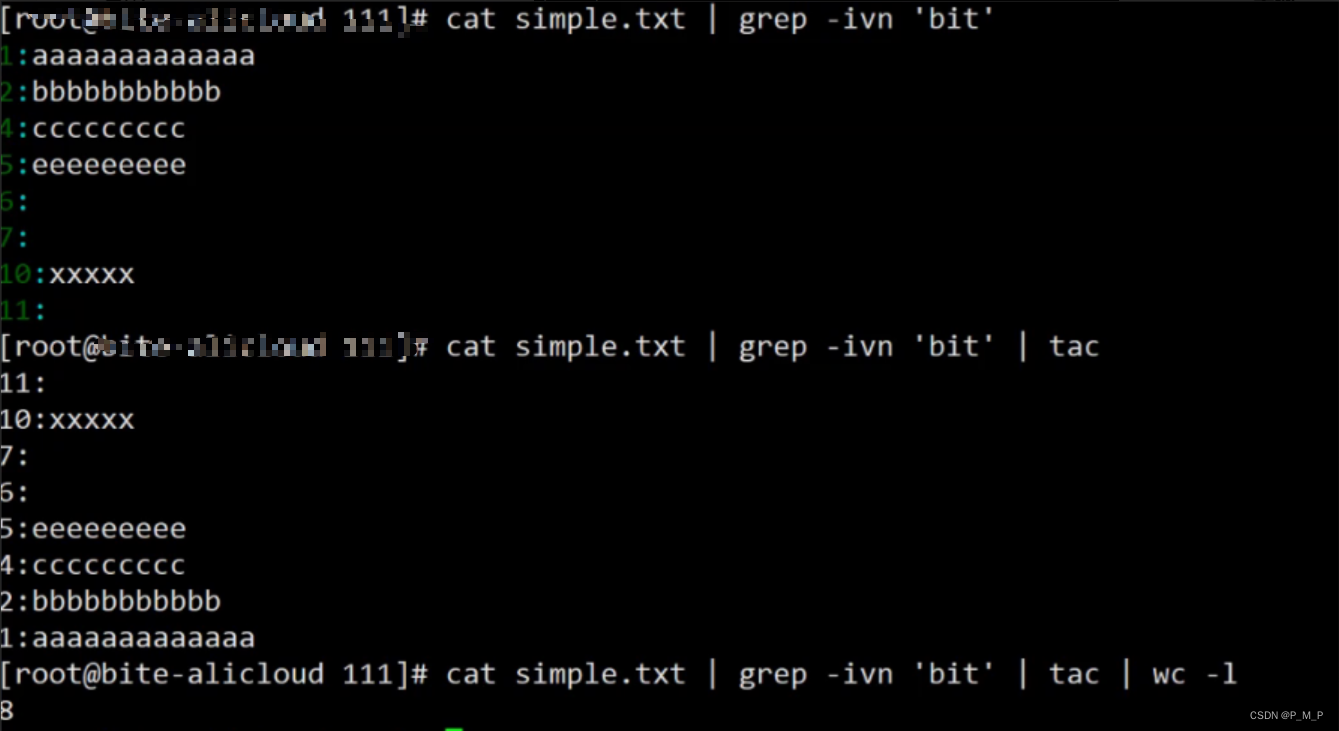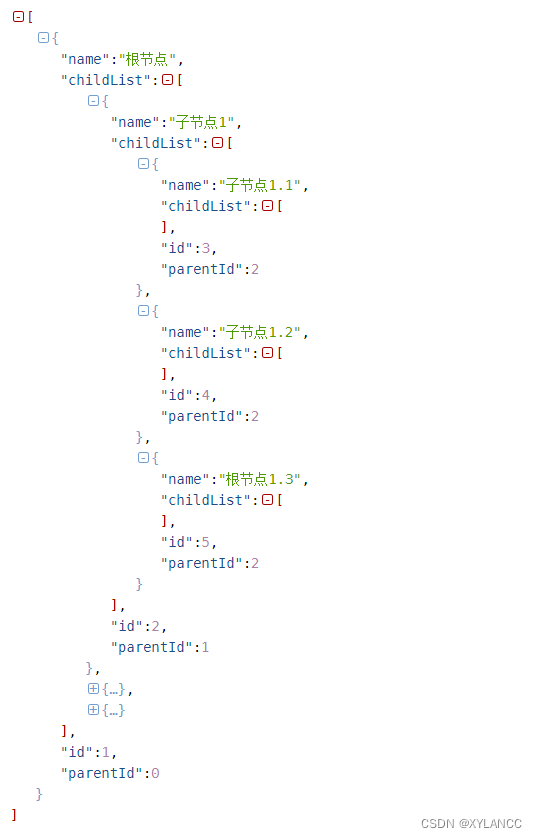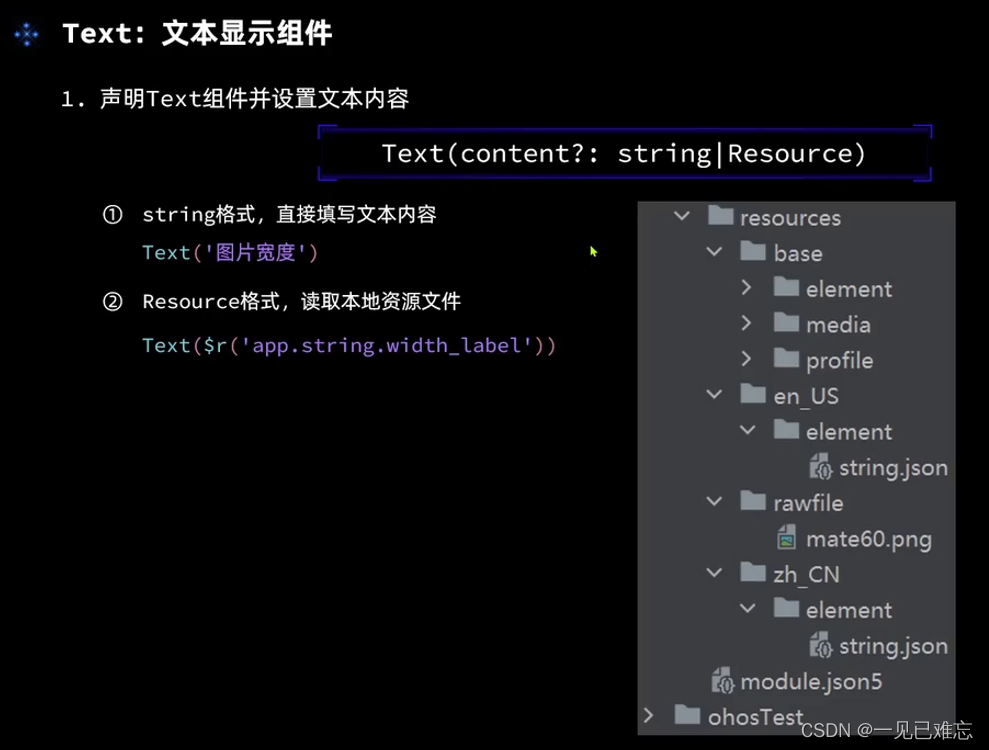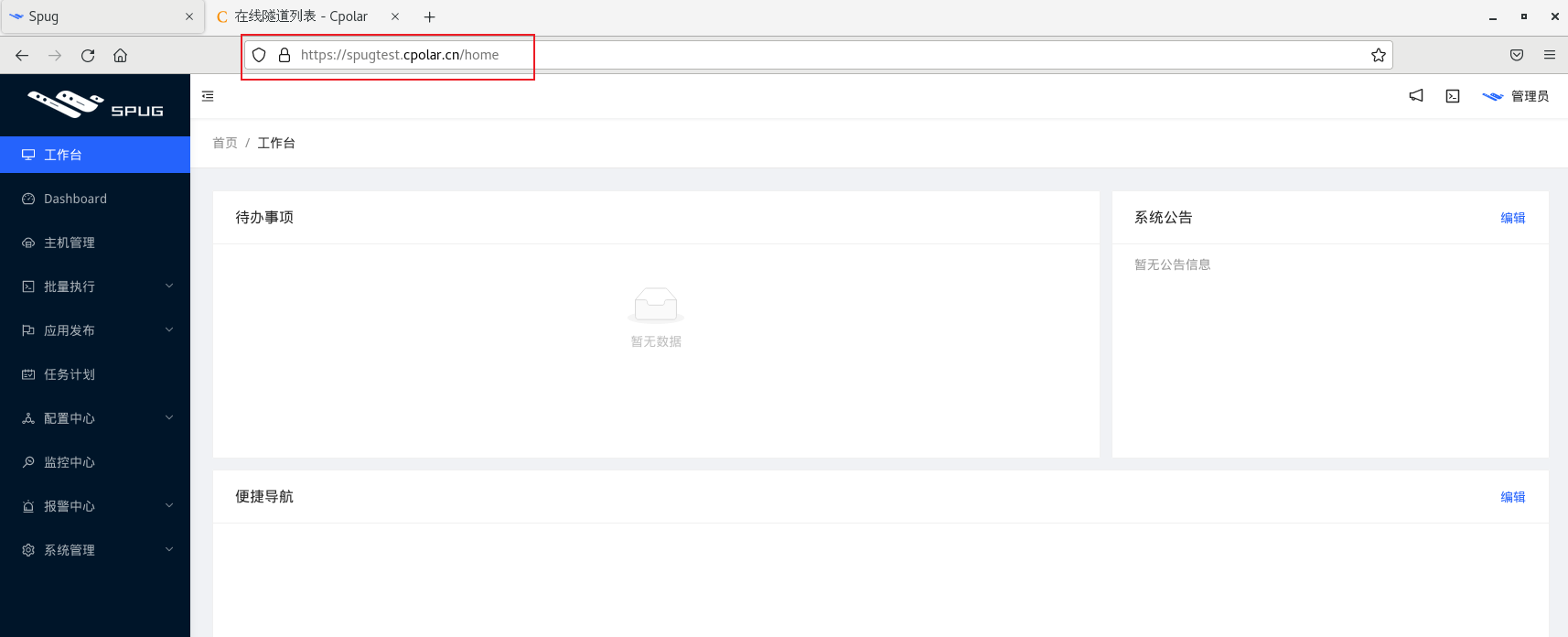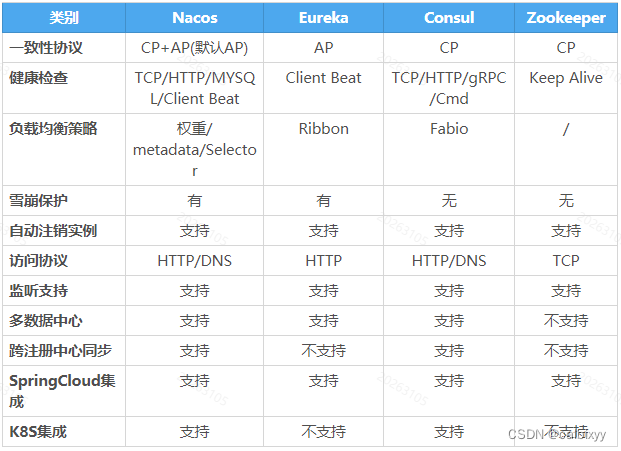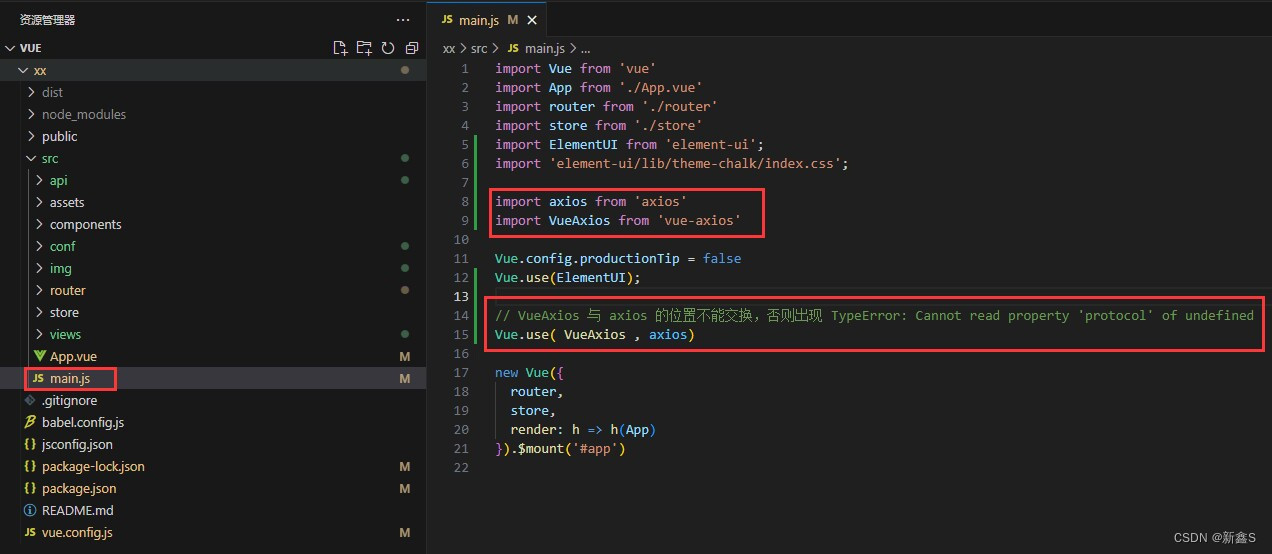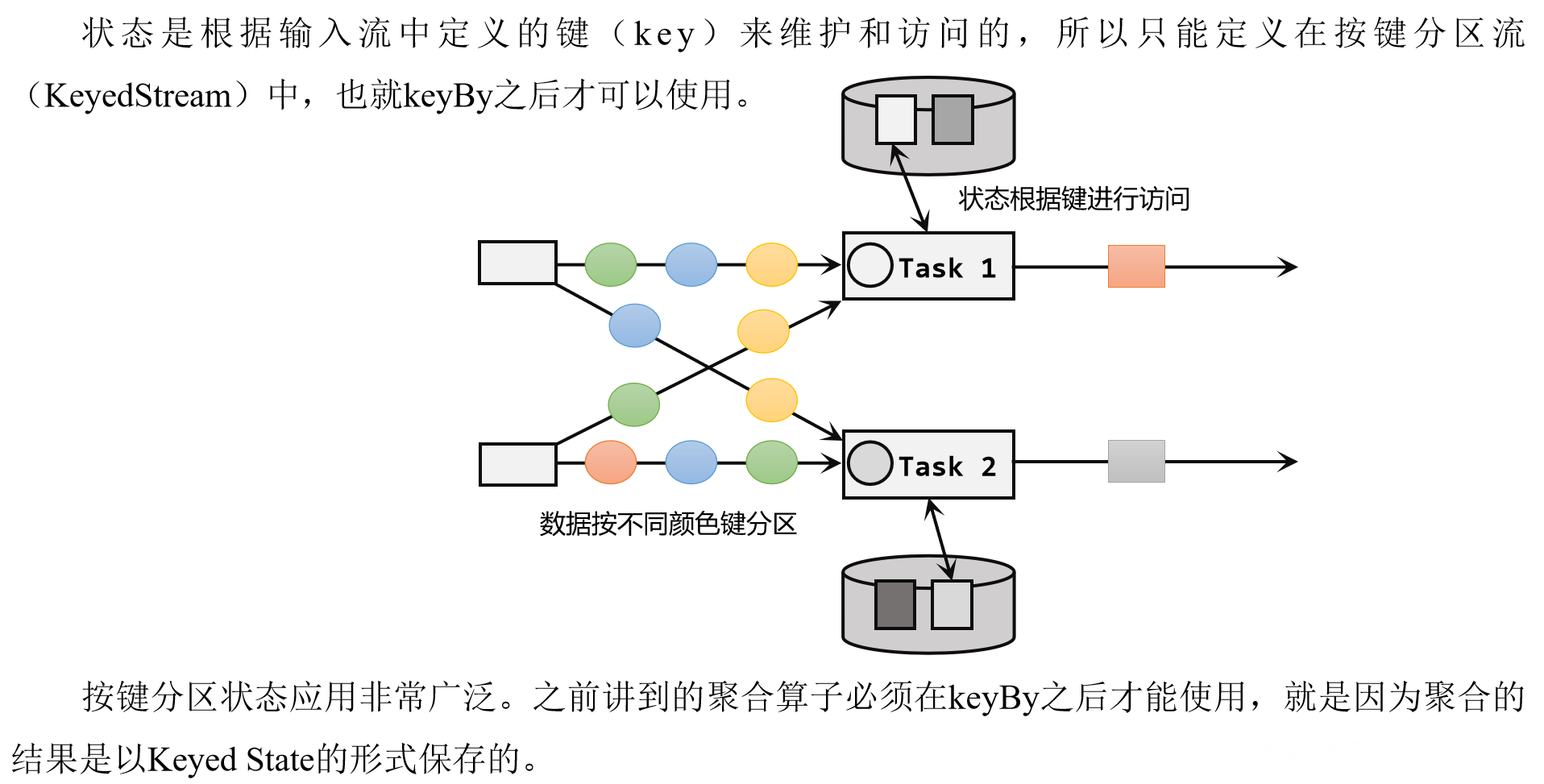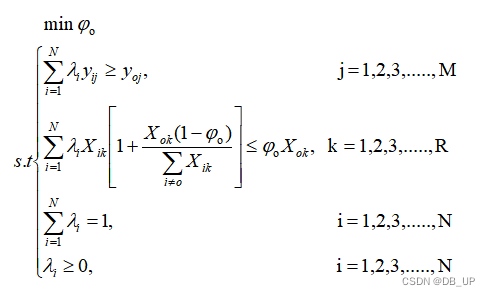文章目录
- 介绍
- 安装 TensorFlow Decision Forests
- 导入库
- 数据集
- 模型结构
- 模型训练
- 评估决策森林
- 下一步是什么?
介绍
欢迎来到TensorFlow Decision Forests(TF-DF)的模型组合教程。本教程将向您展示如何使用通用的预处理层和Keras函数式API将多个决策森林和神经网络模型组合在一起。
您可能希望将模型组合在一起以提高预测性能(集成),以获得不同建模技术的最佳效果(异构模型集成),在不同数据集上训练模型的不同部分(例如预训练),或创建堆叠模型(例如,一个模型在另一个模型的预测上操作)。
本教程涵盖了使用函数式API进行模型组合的高级用例。您可以在本教程的“特征预处理”部分和本教程的“使用预训练文本嵌入”部分中找到更简单的模型组合场景的示例。
以下是您将构建的模型的结构:
# 安装graphviz库
!pip install graphviz -U --quiet
# 导入graphviz库中的Source类
from graphviz import Source
# 创建一个Source对象,传入一个字符串表示的dot语言图形描述
Source("""
digraph G {
raw_data [label="Input features"]; # 创建一个节点,表示原始数据
preprocess_data [label="Learnable NN pre-processing", shape=rect]; # 创建一个节点,表示可学习的神经网络预处理
raw_data -> preprocess_data # 原始数据指向神经网络预处理节点
subgraph cluster_0 {
color=grey;
a1[label="NN layer", shape=rect]; # 创建一个节点,表示神经网络层
b1[label="NN layer", shape=rect]; # 创建一个节点,表示神经网络层
a1 -> b1; # 神经网络层之间的连接
label = "Model #1"; # 设置子图的标签为"Model #1"
}
subgraph cluster_1 {
color=grey;
a2[label="NN layer", shape=rect]; # 创建一个节点,表示神经网络层
b2[label="NN layer", shape=rect]; # 创建一个节点,表示神经网络层
a2 -> b2; # 神经网络层之间的连接
label = "Model #2"; # 设置子图的标签为"Model #2"
}
subgraph cluster_2 {
color=grey;
a3[label="Decision Forest", shape=rect]; # 创建一个节点,表示决策森林
label = "Model #3"; # 设置子图的标签为"Model #3"
}
subgraph cluster_3 {
color=grey;
a4[label="Decision Forest", shape=rect]; # 创建一个节点,表示决策森林
label = "Model #4"; # 设置子图的标签为"Model #4"
}
preprocess_data -> a1; # 神经网络预处理节点指向神经网络层节点
preprocess_data -> a2; # 神经网络预处理节点指向神经网络层节点
preprocess_data -> a3; # 神经网络预处理节点指向决策森林节点
preprocess_data -> a4; # 神经网络预处理节点指向决策森林节点
b1 -> aggr; # 神经网络层节点指向聚合节点
b2 -> aggr; # 神经网络层节点指向聚合节点
a3 -> aggr; # 决策森林节点指向聚合节点
a4 -> aggr; # 决策森林节点指向聚合节点
aggr [label="Aggregation (mean)", shape=rect] # 创建一个节点,表示聚合操作(平均值)
aggr -> predictions # 聚合节点指向预测结果节点
}
""")
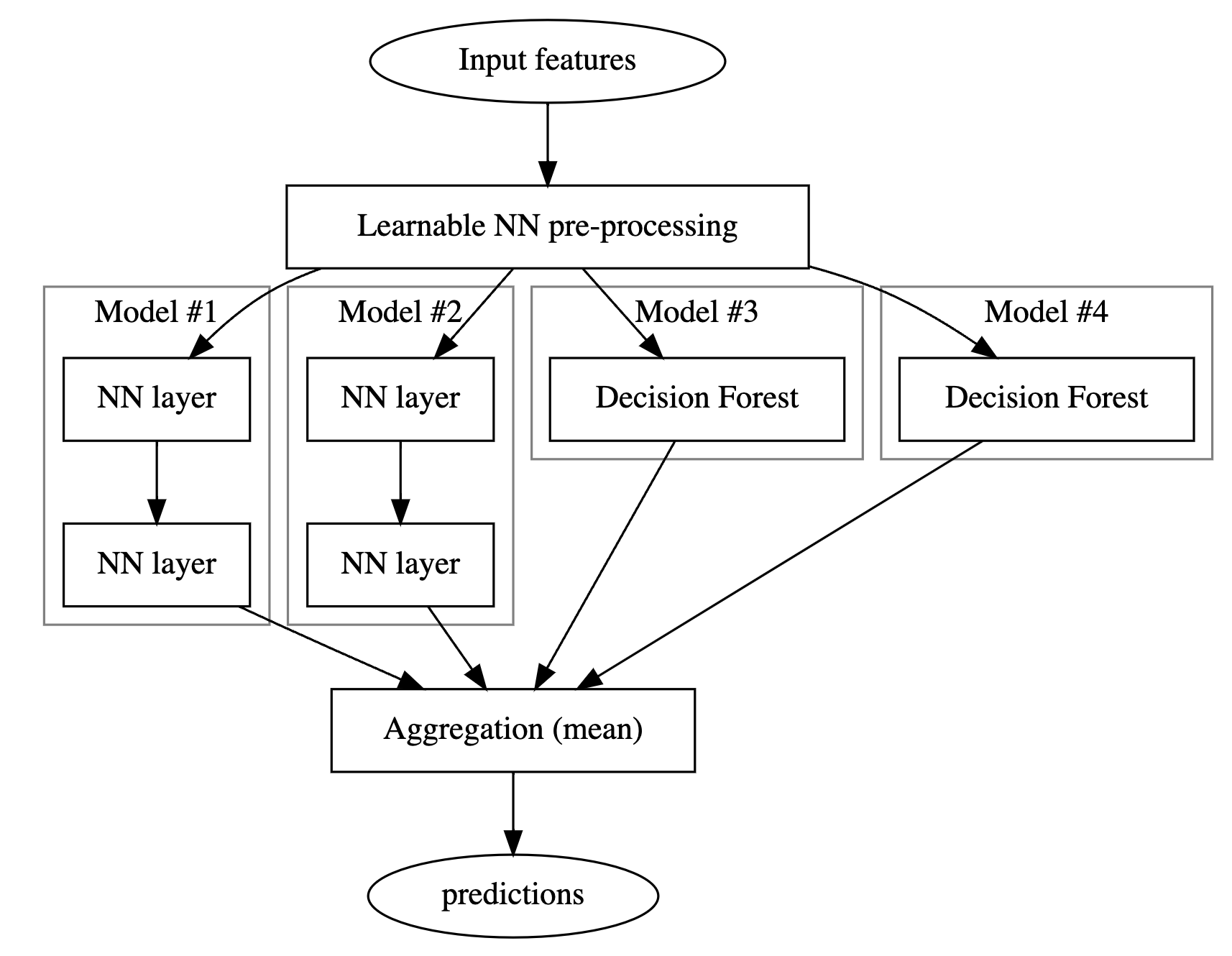
你的组合模型有三个阶段:
- 第一阶段是一个预处理层,由神经网络组成,对下一阶段的所有模型都是共同的。在实践中,这样的预处理层可以是一个预训练的嵌入层进行微调,也可以是一个随机初始化的神经网络。
- 第二阶段是两个决策森林和两个神经网络模型的集合。
- 最后一个阶段是对第二阶段模型的预测进行平均。它不包含任何可学习的权重。
神经网络使用反向传播算法和梯度下降进行训练。该算法具有两个重要特性:(1)如果神经网络层接收到损失梯度(更精确地说,是根据该层的输出计算的损失梯度),则该层可以进行训练;(2)该算法将损失梯度从层的输出“传递”到层的输入(这是“链式法则”)。由于这两个原因,反向传播可以同时训练多层神经网络堆叠在一起。
在这个例子中,决策森林是使用随机森林(RF)算法进行训练的。与反向传播不同,RF的训练不会将损失梯度从其输出传递到其输入。因此,传统的RF算法不能用于训练或微调神经网络。换句话说,“决策森林”阶段不能用于训练“可学习的NN预处理块”。
- 训练预处理和神经网络阶段。
- 训练决策森林阶段。
安装 TensorFlow Decision Forests
通过运行以下单元格来安装 TF-DF。
!pip install tensorflow_decision_forests -U --quiet
Wurlitzer 是在Colabs中显示详细的训练日志所需的(当在模型构造函数中使用verbose=2时)。
# 安装wurlitzer库,用于在Jupyter Notebook中显示命令行输出信息
!pip install wurlitzer -U --quiet
导入库
# 导入所需的库
# 导入tensorflow_decision_forests库
import tensorflow_decision_forests as tfdf
# 导入其他库
import os
import numpy as np
import pandas as pd
import tensorflow as tf
import math
import matplotlib.pyplot as plt
数据集
在本教程中,您将使用一个简单的合成数据集,以便更容易解释最终的模型。
# 定义函数make_dataset,用于生成数据集
# 参数:
# - num_examples: 数据集中的样本数量
# - num_features: 每个样本的特征数量
# - seed: 随机种子,用于生成随机数
# 返回值:
# - features: 生成的特征矩阵,形状为(num_examples, num_features)
# - labels: 生成的标签矩阵,形状为(num_examples,)
def make_dataset(num_examples, num_features, seed=1234):
# 设置随机种子
np.random.seed(seed)
# 生成特征矩阵,形状为(num_examples, num_features)
features = np.random.uniform(-1, 1, size=(num_examples, num_features))
# 生成噪声矩阵,形状为(num_examples,)
noise = np.random.uniform(size=(num_examples))
# 计算左侧部分
left_side = np.sqrt(
np.sum(np.multiply(np.square(features[:, 0:2]), [1, 2]), axis=1))
# 计算右侧部分
right_side = features[:, 2] * 0.7 + np.sin(
features[:, 3] * 10) * 0.5 + noise * 0.0 + 0.5
# 根据左侧和右侧的大小关系,生成标签矩阵
labels = left_side <= right_side
# 将标签矩阵转换为整数类型,并返回特征矩阵和标签矩阵
return features, labels.astype(int)
生成一些示例:
make_dataset(num_examples=5, num_features=4)
(array([[-0.6169611 , 0.24421754, -0.12454452, 0.57071717],
[ 0.55995162, -0.45481479, -0.44707149, 0.60374436],
[ 0.91627871, 0.75186527, -0.28436546, 0.00199025],
[ 0.36692587, 0.42540405, -0.25949849, 0.12239237],
[ 0.00616633, -0.9724631 , 0.54565324, 0.76528238]]),
array([0, 0, 0, 1, 0]))
您还可以绘制它们以了解合成模式的大致情况:
# 生成数据集
plot_features, plot_label = make_dataset(num_examples=50000, num_features=4)
# 设置图形大小
plt.rcParams["figure.figsize"] = [8, 8]
# 设置散点图的公共参数
common_args = dict(c=plot_label, s=1.0, alpha=0.5)
# 创建子图1,并绘制散点图
plt.subplot(2, 2, 1)
plt.scatter(plot_features[:, 0], plot_features[:, 1], **common_args)
# 创建子图2,并绘制散点图
plt.subplot(2, 2, 2)
plt.scatter(plot_features[:, 1], plot_features[:, 2], **common_args)
# 创建子图3,并绘制散点图
plt.subplot(2, 2, 3)
plt.scatter(plot_features[:, 0], plot_features[:, 2], **common_args)
# 创建子图4,并绘制散点图
plt.subplot(2, 2, 4)
plt.scatter(plot_features[:, 0], plot_features[:, 3], **common_args)
<matplotlib.collections.PathCollection at 0x7fad984548e0>
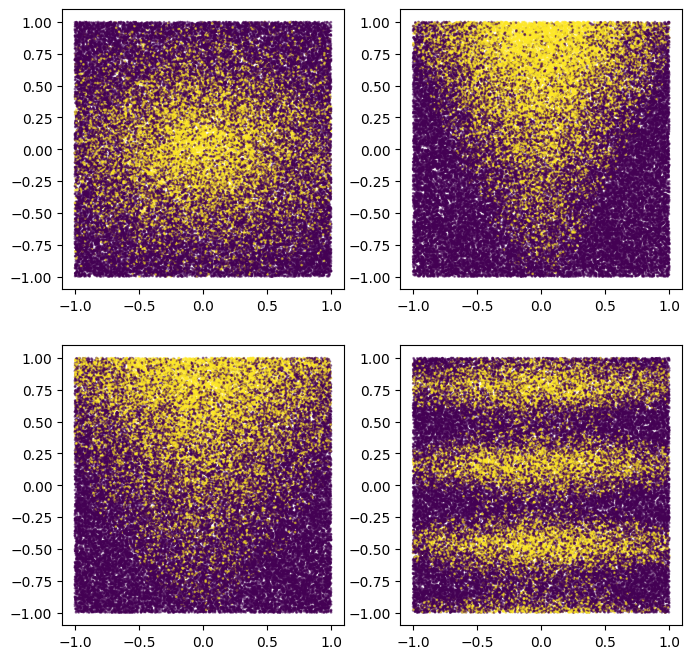
请注意,这种模式是平滑的,而且不是轴对齐的。这将有利于神经网络模型。这是因为对于神经网络来说,拥有圆形和非对齐的决策边界比决策树更容易。
另一方面,我们将在一个包含2500个示例的小数据集上训练模型。这将有利于决策森林模型。这是因为决策森林更加高效,能够利用所有可用的示例信息(决策森林具有“样本高效性”)。
我们的神经网络和决策森林集成将兼具两者的优点。
让我们创建一个训练和测试的tf.data.Dataset:
# 定义函数make_tf_dataset,参数为batch_size和其他参数
def make_tf_dataset(batch_size=64, **args):
# 调用make_dataset函数,返回features和labels
features, labels = make_dataset(**args)
# 使用tf.data.Dataset.from_tensor_slices将features和labels转换为Dataset类型,并按batch_size划分batch
return tf.data.Dataset.from_tensor_slices(
(features, labels)).batch(batch_size)
# 定义变量num_features为10
# 调用make_tf_dataset函数,生成训练集train_dataset,包含2500个样本,每个样本包含num_features个特征,每个batch包含100个样本,随机数种子为1234
train_dataset = make_tf_dataset(
num_examples=2500, num_features=num_features, batch_size=100, seed=1234)
# 调用make_tf_dataset函数,生成测试集test_dataset,包含10000个样本,每个样本包含num_features个特征,每个batch包含100个样本,随机数种子为5678
test_dataset = make_tf_dataset(
num_examples=10000, num_features=num_features, batch_size=100, seed=5678)
模型结构
将模型结构定义如下:
# 输入特征
raw_features = tf.keras.layers.Input(shape=(num_features,))
# 阶段1
# =======
# 公共可学习的预处理
preprocessor = tf.keras.layers.Dense(10, activation=tf.nn.relu6)
preprocess_features = preprocessor(raw_features)
# 阶段2
# =======
# 模型1:神经网络
m1_z1 = tf.keras.layers.Dense(5, activation=tf.nn.relu6)(preprocess_features)
m1_pred = tf.keras.layers.Dense(1, activation=tf.nn.sigmoid)(m1_z1)
# 模型2:神经网络
m2_z1 = tf.keras.layers.Dense(5, activation=tf.nn.relu6)(preprocess_features)
m2_pred = tf.keras.layers.Dense(1, activation=tf.nn.sigmoid)(m2_z1)
# 模型3:决策树随机森林
model_3 = tfdf.keras.RandomForestModel(num_trees=1000, random_seed=1234)
m3_pred = model_3(preprocess_features)
# 模型4:决策树随机森林
model_4 = tfdf.keras.RandomForestModel(
num_trees=1000,
#split_axis="SPARSE_OBLIQUE", # 取消注释此行以提高该模型的质量
random_seed=4567)
m4_pred = model_4(preprocess_features)
# 由于TF-DF使用确定性学习算法,您应该将模型的训练种子设置为不同的值,否则两个`tfdf.keras.RandomForestModel`将完全相同。
# 阶段3
# =======
mean_nn_only = tf.reduce_mean(tf.stack([m1_pred, m2_pred], axis=0), axis=0)
mean_nn_and_df = tf.reduce_mean(
tf.stack([m1_pred, m2_pred, m3_pred, m4_pred], axis=0), axis=0)
# Keras模型
# ============
ensemble_nn_only = tf.keras.models.Model(raw_features, mean_nn_only)
ensemble_nn_and_df = tf.keras.models.Model(raw_features, mean_nn_and_df)
Warning: The `num_threads` constructor argument is not set and the number of CPU is os.cpu_count()=32 > 32. Setting num_threads to 32. Set num_threads manually to use more than 32 cpus.
WARNING:absl:The `num_threads` constructor argument is not set and the number of CPU is os.cpu_count()=32 > 32. Setting num_threads to 32. Set num_threads manually to use more than 32 cpus.
Use /tmpfs/tmp/tmpeqn1u3t4 as temporary training directory
Warning: The model was called directly (i.e. using `model(data)` instead of using `model.predict(data)`) before being trained. The model will only return zeros until trained. The output shape might change after training Tensor("inputs:0", shape=(None, 10), dtype=float32)
WARNING:absl:The model was called directly (i.e. using `model(data)` instead of using `model.predict(data)`) before being trained. The model will only return zeros until trained. The output shape might change after training Tensor("inputs:0", shape=(None, 10), dtype=float32)
Warning: The `num_threads` constructor argument is not set and the number of CPU is os.cpu_count()=32 > 32. Setting num_threads to 32. Set num_threads manually to use more than 32 cpus.
WARNING:absl:The `num_threads` constructor argument is not set and the number of CPU is os.cpu_count()=32 > 32. Setting num_threads to 32. Set num_threads manually to use more than 32 cpus.
Use /tmpfs/tmp/tmpzrq7x74t as temporary training directory
Warning: The model was called directly (i.e. using `model(data)` instead of using `model.predict(data)`) before being trained. The model will only return zeros until trained. The output shape might change after training Tensor("inputs:0", shape=(None, 10), dtype=float32)
WARNING:absl:The model was called directly (i.e. using `model(data)` instead of using `model.predict(data)`) before being trained. The model will only return zeros until trained. The output shape might change after training Tensor("inputs:0", shape=(None, 10), dtype=float32)
在训练模型之前,您可以绘制它以检查它是否与初始图表相似。
# 导入plot_model函数
from keras.utils import plot_model
# 使用plot_model函数将模型ensemble_nn_and_df可视化,并保存为图片
# 参数to_file指定保存的文件路径为/tmp/model.png
# 参数show_shapes设置为True,表示在可视化图中显示每个层的输入输出形状
plot_model(ensemble_nn_and_df, to_file="/tmp/model.png", show_shapes=True)

模型训练
首先使用反向传播算法训练预处理和两个神经网络层。
%%time
# 编译模型
ensemble_nn_only.compile(
optimizer=tf.keras.optimizers.Adam(), # 使用Adam优化器来优化模型的参数
loss=tf.keras.losses.BinaryCrossentropy(), # 使用二元交叉熵作为损失函数
metrics=["accuracy"] # 使用准确率作为评估指标
)
# 训练模型
ensemble_nn_only.fit(
train_dataset, # 使用训练数据集进行训练
epochs=20, # 迭代20次
validation_data=test_dataset # 使用测试数据集进行验证
)
Epoch 1/20
1/25 [>.............................] - ETA: 1:49 - loss: 0.5916 - accuracy: 0.7200
18/25 [====================>.........] - ETA: 0s - loss: 0.5695 - accuracy: 0.7556
25/25 [==============================] - 5s 15ms/step - loss: 0.5691 - accuracy: 0.7500 - val_loss: 0.5662 - val_accuracy: 0.7392
Epoch 2/20
1/25 [>.............................] - ETA: 0s - loss: 0.5743 - accuracy: 0.7200
19/25 [=====================>........] - ETA: 0s - loss: 0.5510 - accuracy: 0.7574
25/25 [==============================] - 0s 9ms/step - loss: 0.5542 - accuracy: 0.7500 - val_loss: 0.5554 - val_accuracy: 0.7392
Epoch 3/20
1/25 [>.............................] - ETA: 0s - loss: 0.5623 - accuracy: 0.7200
19/25 [=====================>........] - ETA: 0s - loss: 0.5396 - accuracy: 0.7574
25/25 [==============================] - 0s 9ms/step - loss: 0.5434 - accuracy: 0.7500 - val_loss: 0.5467 - val_accuracy: 0.7392
Epoch 4/20
1/25 [>.............................] - ETA: 0s - loss: 0.5525 - accuracy: 0.7200
17/25 [===================>..........] - ETA: 0s - loss: 0.5362 - accuracy: 0.7529
25/25 [==============================] - 0s 10ms/step - loss: 0.5342 - accuracy: 0.7500 - val_loss: 0.5384 - val_accuracy: 0.7392
Epoch 5/20
1/25 [>.............................] - ETA: 0s - loss: 0.5433 - accuracy: 0.7200
18/25 [====================>.........] - ETA: 0s - loss: 0.5244 - accuracy: 0.7556
25/25 [==============================] - 0s 10ms/step - loss: 0.5250 - accuracy: 0.7500 - val_loss: 0.5298 - val_accuracy: 0.7392
Epoch 6/20
1/25 [>.............................] - ETA: 0s - loss: 0.5338 - accuracy: 0.7200
18/25 [====================>.........] - ETA: 0s - loss: 0.5152 - accuracy: 0.7556
25/25 [==============================] - 0s 10ms/step - loss: 0.5154 - accuracy: 0.7500 - val_loss: 0.5205 - val_accuracy: 0.7392
Epoch 7/20
1/25 [>.............................] - ETA: 0s - loss: 0.5241 - accuracy: 0.7200
19/25 [=====================>........] - ETA: 0s - loss: 0.5023 - accuracy: 0.7574
25/25 [==============================] - 0s 10ms/step - loss: 0.5053 - accuracy: 0.7500 - val_loss: 0.5107 - val_accuracy: 0.7392
Epoch 8/20
1/25 [>.............................] - ETA: 0s - loss: 0.5137 - accuracy: 0.7200
19/25 [=====================>........] - ETA: 0s - loss: 0.4921 - accuracy: 0.7574
25/25 [==============================] - 0s 10ms/step - loss: 0.4947 - accuracy: 0.7500 - val_loss: 0.5007 - val_accuracy: 0.7392
Epoch 9/20
1/25 [>.............................] - ETA: 0s - loss: 0.5029 - accuracy: 0.7200
18/25 [====================>.........] - ETA: 0s - loss: 0.4854 - accuracy: 0.7556
25/25 [==============================] - 0s 10ms/step - loss: 0.4841 - accuracy: 0.7500 - val_loss: 0.4909 - val_accuracy: 0.7392
Epoch 10/20
1/25 [>.............................] - ETA: 0s - loss: 0.4916 - accuracy: 0.7200
19/25 [=====================>........] - ETA: 0s - loss: 0.4717 - accuracy: 0.7574
25/25 [==============================] - 0s 10ms/step - loss: 0.4738 - accuracy: 0.7500 - val_loss: 0.4815 - val_accuracy: 0.7392
Epoch 11/20
1/25 [>.............................] - ETA: 0s - loss: 0.4799 - accuracy: 0.7200
19/25 [=====================>........] - ETA: 0s - loss: 0.4618 - accuracy: 0.7574
25/25 [==============================] - 0s 9ms/step - loss: 0.4637 - accuracy: 0.7500 - val_loss: 0.4724 - val_accuracy: 0.7392
Epoch 12/20
1/25 [>.............................] - ETA: 0s - loss: 0.4680 - accuracy: 0.7200
19/25 [=====================>........] - ETA: 0s - loss: 0.4522 - accuracy: 0.7574
25/25 [==============================] - 0s 9ms/step - loss: 0.4541 - accuracy: 0.7500 - val_loss: 0.4639 - val_accuracy: 0.7392
Epoch 13/20
1/25 [>.............................] - ETA: 0s - loss: 0.4559 - accuracy: 0.7200
18/25 [====================>.........] - ETA: 0s - loss: 0.4473 - accuracy: 0.7556
25/25 [==============================] - 0s 9ms/step - loss: 0.4453 - accuracy: 0.7500 - val_loss: 0.4561 - val_accuracy: 0.7392
Epoch 14/20
1/25 [>.............................] - ETA: 0s - loss: 0.4441 - accuracy: 0.7200
18/25 [====================>.........] - ETA: 0s - loss: 0.4392 - accuracy: 0.7556
25/25 [==============================] - 0s 9ms/step - loss: 0.4373 - accuracy: 0.7500 - val_loss: 0.4491 - val_accuracy: 0.7398
Epoch 15/20
1/25 [>.............................] - ETA: 0s - loss: 0.4332 - accuracy: 0.7300
19/25 [=====================>........] - ETA: 0s - loss: 0.4280 - accuracy: 0.7621
25/25 [==============================] - 0s 10ms/step - loss: 0.4300 - accuracy: 0.7552 - val_loss: 0.4426 - val_accuracy: 0.7439
Epoch 16/20
1/25 [>.............................] - ETA: 0s - loss: 0.4227 - accuracy: 0.7300
18/25 [====================>.........] - ETA: 0s - loss: 0.4252 - accuracy: 0.7667
25/25 [==============================] - 0s 10ms/step - loss: 0.4234 - accuracy: 0.7624 - val_loss: 0.4366 - val_accuracy: 0.7508
Epoch 17/20
1/25 [>.............................] - ETA: 0s - loss: 0.4132 - accuracy: 0.7400
19/25 [=====================>........] - ETA: 0s - loss: 0.4153 - accuracy: 0.7753
25/25 [==============================] - 0s 9ms/step - loss: 0.4173 - accuracy: 0.7692 - val_loss: 0.4310 - val_accuracy: 0.7608
Epoch 18/20
1/25 [>.............................] - ETA: 0s - loss: 0.4047 - accuracy: 0.7500
19/25 [=====================>........] - ETA: 0s - loss: 0.4095 - accuracy: 0.7800
25/25 [==============================] - 0s 9ms/step - loss: 0.4115 - accuracy: 0.7764 - val_loss: 0.4255 - val_accuracy: 0.7752
Epoch 19/20
1/25 [>.............................] - ETA: 0s - loss: 0.3966 - accuracy: 0.7600
18/25 [====================>.........] - ETA: 0s - loss: 0.4076 - accuracy: 0.7922
25/25 [==============================] - 0s 10ms/step - loss: 0.4059 - accuracy: 0.7880 - val_loss: 0.4201 - val_accuracy: 0.7847
Epoch 20/20
1/25 [>.............................] - ETA: 0s - loss: 0.3887 - accuracy: 0.7900
19/25 [=====================>........] - ETA: 0s - loss: 0.3981 - accuracy: 0.8053
25/25 [==============================] - 0s 9ms/step - loss: 0.4003 - accuracy: 0.7988 - val_loss: 0.4148 - val_accuracy: 0.7913
CPU times: user 8.67 s, sys: 1.46 s, total: 10.1 s
Wall time: 9.49 s
<keras.src.callbacks.History at 0x7fac640c79a0>
让我们评估仅包括预处理和两个神经网络部分的内容:
# 评估神经网络模型(仅使用NN #1和NN #2)
evaluation_nn_only = ensemble_nn_only.evaluate(test_dataset, return_dict=True)
# 打印准确率(仅使用NN #1和NN #2)
print("Accuracy (NN #1 and #2 only): ", evaluation_nn_only["accuracy"])
# 打印损失值(仅使用NN #1和NN #2)
print("Loss (NN #1 and #2 only): ", evaluation_nn_only["loss"])
1/100 [..............................] - ETA: 0s - loss: 0.3536 - accuracy: 0.8400
30/100 [========>.....................] - ETA: 0s - loss: 0.4103 - accuracy: 0.7967
59/100 [================>.............] - ETA: 0s - loss: 0.4093 - accuracy: 0.7920
88/100 [=========================>....] - ETA: 0s - loss: 0.4119 - accuracy: 0.7917
100/100 [==============================] - 0s 2ms/step - loss: 0.4148 - accuracy: 0.7913
Accuracy (NN #1 and #2 only): 0.7912999987602234
Loss (NN #1 and #2 only): 0.4147580564022064
让我们依次训练两个决策森林组件。
# 对训练数据集进行预处理
# 使用map函数对train_dataset中的每个样本进行预处理,preprocessor函数用于对样本进行处理
# 返回的结果是一个新的数据集train_dataset_with_preprocessing,其中每个样本都经过了预处理
train_dataset_with_preprocessing = train_dataset.map(lambda x,y: (preprocessor(x), y))
# 对测试数据集进行预处理
# 使用map函数对test_dataset中的每个样本进行预处理,preprocessor函数用于对样本进行处理
# 返回的结果是一个新的数据集test_dataset_with_preprocessing,其中每个样本都经过了预处理
test_dataset_with_preprocessing = test_dataset.map(lambda x,y: (preprocessor(x), y))
# 使用model_3对预处理后的训练数据集进行训练
model_3.fit(train_dataset_with_preprocessing)
# 使用model_4对预处理后的训练数据集进行训练
model_4.fit(train_dataset_with_preprocessing)
WARNING:tensorflow:AutoGraph could not transform <function <lambda> at 0x7fad5d4b6700> and will run it as-is.
Cause: could not parse the source code of <function <lambda> at 0x7fad5d4b6700>: no matching AST found among candidates:
To silence this warning, decorate the function with @tf.autograph.experimental.do_not_convert
WARNING:tensorflow:AutoGraph could not transform <function <lambda> at 0x7fad5d4b6700> and will run it as-is.
Cause: could not parse the source code of <function <lambda> at 0x7fad5d4b6700>: no matching AST found among candidates:
To silence this warning, decorate the function with @tf.autograph.experimental.do_not_convert
WARNING: AutoGraph could not transform <function <lambda> at 0x7fad5d4b6700> and will run it as-is.
Cause: could not parse the source code of <function <lambda> at 0x7fad5d4b6700>: no matching AST found among candidates:
To silence this warning, decorate the function with @tf.autograph.experimental.do_not_convert
WARNING:tensorflow:AutoGraph could not transform <function <lambda> at 0x7facb40f80d0> and will run it as-is.
Cause: could not parse the source code of <function <lambda> at 0x7facb40f80d0>: no matching AST found among candidates:
To silence this warning, decorate the function with @tf.autograph.experimental.do_not_convert
WARNING:tensorflow:AutoGraph could not transform <function <lambda> at 0x7facb40f80d0> and will run it as-is.
Cause: could not parse the source code of <function <lambda> at 0x7facb40f80d0>: no matching AST found among candidates:
To silence this warning, decorate the function with @tf.autograph.experimental.do_not_convert
WARNING: AutoGraph could not transform <function <lambda> at 0x7facb40f80d0> and will run it as-is.
Cause: could not parse the source code of <function <lambda> at 0x7facb40f80d0>: no matching AST found among candidates:
To silence this warning, decorate the function with @tf.autograph.experimental.do_not_convert
Reading training dataset...
Training dataset read in 0:00:03.527053. Found 2500 examples.
Training model...
[INFO 23-07-10 11:10:25.0183 UTC kernel.cc:1243] Loading model from path /tmpfs/tmp/tmpeqn1u3t4/model/ with prefix 03256340d0ca40b0
Model trained in 0:00:01.894803
Compiling model...
[INFO 23-07-10 11:10:25.9915 UTC decision_forest.cc:660] Model loaded with 1000 root(s), 314626 node(s), and 10 input feature(s).
[INFO 23-07-10 11:10:25.9915 UTC abstract_model.cc:1311] Engine "RandomForestOptPred" built
[INFO 23-07-10 11:10:25.9916 UTC kernel.cc:1075] Use fast generic engine
WARNING:tensorflow:AutoGraph could not transform <function simple_ml_inference_op_with_handle at 0x7fac685de700> and will run it as-is.
Please report this to the TensorFlow team. When filing the bug, set the verbosity to 10 (on Linux, `export AUTOGRAPH_VERBOSITY=10`) and attach the full output.
Cause: could not get source code
To silence this warning, decorate the function with @tf.autograph.experimental.do_not_convert
WARNING:tensorflow:AutoGraph could not transform <function simple_ml_inference_op_with_handle at 0x7fac685de700> and will run it as-is.
Please report this to the TensorFlow team. When filing the bug, set the verbosity to 10 (on Linux, `export AUTOGRAPH_VERBOSITY=10`) and attach the full output.
Cause: could not get source code
To silence this warning, decorate the function with @tf.autograph.experimental.do_not_convert
WARNING: AutoGraph could not transform <function simple_ml_inference_op_with_handle at 0x7fac685de700> and will run it as-is.
Please report this to the TensorFlow team. When filing the bug, set the verbosity to 10 (on Linux, `export AUTOGRAPH_VERBOSITY=10`) and attach the full output.
Cause: could not get source code
To silence this warning, decorate the function with @tf.autograph.experimental.do_not_convert
Model compiled.
Reading training dataset...
Training dataset read in 0:00:00.210194. Found 2500 examples.
Training model...
[INFO 23-07-10 11:10:28.3455 UTC kernel.cc:1243] Loading model from path /tmpfs/tmp/tmpzrq7x74t/model/ with prefix a093792264d04fac
Model trained in 0:00:01.800354
Compiling model...
[INFO 23-07-10 11:10:29.2816 UTC decision_forest.cc:660] Model loaded with 1000 root(s), 316314 node(s), and 10 input feature(s).
[INFO 23-07-10 11:10:29.2816 UTC kernel.cc:1075] Use fast generic engine
Model compiled.
CPU times: user 20.1 s, sys: 1.49 s, total: 21.6 s
Wall time: 8.92 s
<keras.src.callbacks.History at 0x7fac5073e430>
评估决策森林
让我们逐个评估决策森林。
# 给模型添加评估指标
model_3.compile(["accuracy"])
model_4.compile(["accuracy"])
# 使用预处理后的测试数据对模型3进行评估,并返回评估结果的字典形式
evaluation_df3_only = model_3.evaluate(test_dataset_with_preprocessing, return_dict=True)
# 使用预处理后的测试数据对模型4进行评估,并返回评估结果的字典形式
evaluation_df4_only = model_4.evaluate(test_dataset_with_preprocessing, return_dict=True)
# 打印模型3的准确率评估结果
print("Accuracy (DF #3 only): ", evaluation_df3_only["accuracy"])
# 打印模型4的准确率评估结果
print("Accuracy (DF #4 only): ", evaluation_df4_only["accuracy"])
1/100 [..............................] - ETA: 29s - loss: 0.0000e+00 - accuracy: 0.8600
6/100 [>.............................] - ETA: 0s - loss: 0.0000e+00 - accuracy: 0.8200
12/100 [==>...........................] - ETA: 0s - loss: 0.0000e+00 - accuracy: 0.8300
17/100 [====>.........................] - ETA: 0s - loss: 0.0000e+00 - accuracy: 0.8218
22/100 [=====>........................] - ETA: 0s - loss: 0.0000e+00 - accuracy: 0.8173
28/100 [=======>......................] - ETA: 0s - loss: 0.0000e+00 - accuracy: 0.8129
34/100 [=========>....................] - ETA: 0s - loss: 0.0000e+00 - accuracy: 0.8124
40/100 [===========>..................] - ETA: 0s - loss: 0.0000e+00 - accuracy: 0.8138
46/100 [============>.................] - ETA: 0s - loss: 0.0000e+00 - accuracy: 0.8161
52/100 [==============>...............] - ETA: 0s - loss: 0.0000e+00 - accuracy: 0.8173
58/100 [================>.............] - ETA: 0s - loss: 0.0000e+00 - accuracy: 0.8178
64/100 [==================>...........] - ETA: 0s - loss: 0.0000e+00 - accuracy: 0.8156
69/100 [===================>..........] - ETA: 0s - loss: 0.0000e+00 - accuracy: 0.8165
75/100 [=====================>........] - ETA: 0s - loss: 0.0000e+00 - accuracy: 0.8175
80/100 [=======================>......] - ETA: 0s - loss: 0.0000e+00 - accuracy: 0.8166
86/100 [========================>.....] - ETA: 0s - loss: 0.0000e+00 - accuracy: 0.8166
92/100 [==========================>...] - ETA: 0s - loss: 0.0000e+00 - accuracy: 0.8153
98/100 [============================>.] - ETA: 0s - loss: 0.0000e+00 - accuracy: 0.8152
100/100 [==============================] - 1s 10ms/step - loss: 0.0000e+00 - accuracy: 0.8150
1/100 [..............................] - ETA: 12s - loss: 0.0000e+00 - accuracy: 0.8500
6/100 [>.............................] - ETA: 0s - loss: 0.0000e+00 - accuracy: 0.8250
12/100 [==>...........................] - ETA: 0s - loss: 0.0000e+00 - accuracy: 0.8325
18/100 [====>.........................] - ETA: 0s - loss: 0.0000e+00 - accuracy: 0.8228
24/100 [======>.......................] - ETA: 0s - loss: 0.0000e+00 - accuracy: 0.8158
30/100 [========>.....................] - ETA: 0s - loss: 0.0000e+00 - accuracy: 0.8127
36/100 [=========>....................] - ETA: 0s - loss: 0.0000e+00 - accuracy: 0.8122
42/100 [===========>..................] - ETA: 0s - loss: 0.0000e+00 - accuracy: 0.8148
48/100 [=============>................] - ETA: 0s - loss: 0.0000e+00 - accuracy: 0.8144
54/100 [===============>..............] - ETA: 0s - loss: 0.0000e+00 - accuracy: 0.8176
60/100 [=================>............] - ETA: 0s - loss: 0.0000e+00 - accuracy: 0.8153
66/100 [==================>...........] - ETA: 0s - loss: 0.0000e+00 - accuracy: 0.8150
71/100 [====================>.........] - ETA: 0s - loss: 0.0000e+00 - accuracy: 0.8169
76/100 [=====================>........] - ETA: 0s - loss: 0.0000e+00 - accuracy: 0.8176
81/100 [=======================>......] - ETA: 0s - loss: 0.0000e+00 - accuracy: 0.8167
86/100 [========================>.....] - ETA: 0s - loss: 0.0000e+00 - accuracy: 0.8162
91/100 [==========================>...] - ETA: 0s - loss: 0.0000e+00 - accuracy: 0.8149
96/100 [===========================>..] - ETA: 0s - loss: 0.0000e+00 - accuracy: 0.8147
100/100 [==============================] - 1s 10ms/step - loss: 0.0000e+00 - accuracy: 0.8149
Accuracy (DF #3 only): 0.8149999976158142
Accuracy (DF #4 only): 0.8148999810218811
让我们评估整个模型组合:
# 编译模型
ensemble_nn_and_df.compile(
loss=tf.keras.losses.BinaryCrossentropy(), metrics=["accuracy"])
# 评估模型
evaluation_nn_and_df = ensemble_nn_and_df.evaluate(
test_dataset, return_dict=True)
# 打印准确率和损失值
print("Accuracy (2xNN and 2xDF): ", evaluation_nn_and_df["accuracy"])
print("Loss (2xNN and 2xDF): ", evaluation_nn_and_df["loss"])
1/100 [..............................] - ETA: 23s - loss: 0.3324 - accuracy: 0.8600
6/100 [>.............................] - ETA: 0s - loss: 0.3850 - accuracy: 0.8267
12/100 [==>...........................] - ETA: 0s - loss: 0.3650 - accuracy: 0.8317
18/100 [====>.........................] - ETA: 0s - loss: 0.3679 - accuracy: 0.8261
24/100 [======>.......................] - ETA: 0s - loss: 0.3723 - accuracy: 0.8229
30/100 [========>.....................] - ETA: 0s - loss: 0.3752 - accuracy: 0.8200
35/100 [=========>....................] - ETA: 0s - loss: 0.3742 - accuracy: 0.8200
40/100 [===========>..................] - ETA: 0s - loss: 0.3736 - accuracy: 0.8198
46/100 [============>.................] - ETA: 0s - loss: 0.3723 - accuracy: 0.8207
52/100 [==============>...............] - ETA: 0s - loss: 0.3716 - accuracy: 0.8213
58/100 [================>.............] - ETA: 0s - loss: 0.3722 - accuracy: 0.8193
64/100 [==================>...........] - ETA: 0s - loss: 0.3754 - accuracy: 0.8178
70/100 [====================>.........] - ETA: 0s - loss: 0.3745 - accuracy: 0.8184
76/100 [=====================>........] - ETA: 0s - loss: 0.3753 - accuracy: 0.8170
82/100 [=======================>......] - ETA: 0s - loss: 0.3757 - accuracy: 0.8151
88/100 [=========================>....] - ETA: 0s - loss: 0.3760 - accuracy: 0.8147
94/100 [===========================>..] - ETA: 0s - loss: 0.3785 - accuracy: 0.8130
100/100 [==============================] - ETA: 0s - loss: 0.3795 - accuracy: 0.8133
100/100 [==============================] - 1s 10ms/step - loss: 0.3795 - accuracy: 0.8133
Accuracy (2xNN and 2xDF): 0.8133000135421753
Loss (2xNN and 2xDF): 0.37953513860702515
为了完成任务,让我们对神经网络层进行更多微调。请注意,我们不对预训练的嵌入进行微调,因为DF模型依赖于它(除非我们在之后也重新训练它们)。
总结一下,你有:
# 输出NN #1和#2的准确率
print(f"Accuracy (NN #1 and #2 only):\t{evaluation_nn_only['accuracy']:.6f}")
# 输出DF #3的准确率
print(f"Accuracy (DF #3 only):\t\t{evaluation_df3_only['accuracy']:.6f}")
# 输出DF #4的准确率
print(f"Accuracy (DF #4 only):\t\t{evaluation_df4_only['accuracy']:.6f}")
# 输出分割线
print("----------------------------------------")
# 输出2xNN和2xDF的准确率
print(f"Accuracy (2xNN and 2xDF):\t{evaluation_nn_and_df['accuracy']:.6f}")
# 定义一个函数,计算准确率的增长百分比
def delta_percent(src_eval, key):
# 获取源准确率
src_acc = src_eval["accuracy"]
# 获取最终准确率
final_acc = evaluation_nn_and_df["accuracy"]
# 计算准确率的增长
increase = final_acc - src_acc
# 输出增长百分比
print(f"\t\t\t\t {increase:+.6f} over {key}")
# 分别计算NN #1和#2、DF #3、DF #4的准确率增长百分比
delta_percent(evaluation_nn_only, "NN #1 and #2 only")
delta_percent(evaluation_df3_only, "DF #3 only")
delta_percent(evaluation_df4_only, "DF #4 only")
Accuracy (NN #1 and #2 only): 0.791300
Accuracy (DF #3 only): 0.815000
Accuracy (DF #4 only): 0.814900
----------------------------------------
Accuracy (2xNN and 2xDF): 0.813300
+0.022000 over NN #1 and #2 only
-0.001700 over DF #3 only
-0.001600 over DF #4 only
在这里,你可以看到组合模型的表现优于其各个部分。这就是为什么集成方法如此有效。
下一步是什么?
在这个例子中,你看到了如何将决策森林与神经网络结合起来。进一步训练神经网络和决策森林的一个额外步骤。
此外,为了清晰起见,决策森林只接收预处理的输入。然而,决策森林通常很擅长消耗原始数据。通过将原始特征也提供给决策森林模型,可以改善模型。
在这个例子中,最终模型是各个模型预测的平均值。如果所有模型的表现都差不多,这个解决方案效果很好。然而,如果其中一个子模型非常好,将其与其他模型聚合可能会实际上有害(或反之亦然;例如尝试减少1k个示例的数量,看看它如何严重影响神经网络;或在第二个随机森林模型中启用“SPARSE_OBLIQUE”分裂)。








